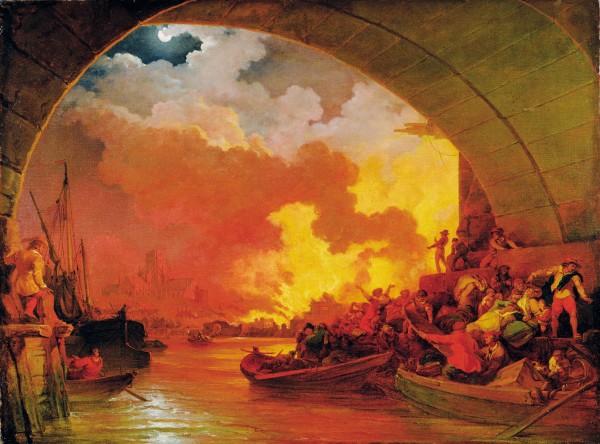Painting weather

It is hardly surprising that weather, so central a factor in human affairs, should be a major component of landscape art. Clouds and sunlight contribute significantly to the mood a painting evokes. Contrast, for example, J. M. W. Turner’s mellow golden sunsets with the swirling black cauldrons of cloud in his paintings of storms and shipwrecks.
In much of New Zealand’s early landscape painting, including the work of Kinder, Fox, Heaphy and Gulley, the weather is portrayed as benign. Perhaps the painters wanted to document the nature of the land without letting atmospheric conditions get in the way. Alternatively, they may have wished—or felt obliged—to show New Zealand as a more hospitable environment for settlement than it actually was. In many of their works, steep hills are flattened, implying easy access, swampland is generously depicted as grassland suitable for grazing, and what clouds sully the sky are often bathed in the flattering colours of sunset. Indeed, some of Heaphy’s early paintings were exhibited in England to encourage immigration.
In John Gibbs’ After the Storm, painted in 1883, the weather is shown to be a dangerous adversary, a destroyer of ships. The Benvenue leans sideways on the rocks at Caroline Bay, Timaru, one mast gone, the other two just clear of the water. But her flag is still flying bravely, perhaps in recognition of the fact that the wreck was not a tragedy, as no lives were lost. When the anchor cable broke under the force of wind and waves, the crew had time to lower a boat and row to another ship before their own was driven on to the rocks.
The seas crashing against the cliff face, as if besieging the land and the people on it, convey a sense of battle with the elements. The cliffs have more than a hint of castle walls about them, with the figures on top defiantly seeing off the departing foe, depicted as black clouds breaking open to let the light through.
In contrast, the weather is seen as an ally in James McLachlin Nairns’ 1901 painting Oatfi elds, Otago. Here fertile soil and an agreeable climate combine to bless the settlers with an abundant crop. The angle of the oats and the curve of the hill lead the eye up into a sky full of fluffy white clouds, which in turn direct the viewer down to the strong yellows of the fields below. The rounded shapes of the cumulus echo the bounty of the earth. Their presence is a reminder of the rains that have fallen to nourish the crop, yet their non-threatening appearance implies they are not about to ruin the harvest.
This bucolic image of harmonious nature nurturing humans seems but one step removed from cereal- packet advertising. The farmer with his rake over his shoulder and the girl holding his hand anticipate such figures as the energetic boy who used to come running happily towards us from salt packets 50 years ago.
There are no people in the way of the weather in Petrus van der Velden’s Otira Gorge, painted in 1912, in which the artist appears to be relishing the raw power of the storm. Van der Velden was already a well-established Dutch painter when he arrived in New Zealand in 1890 at the age of 53. He had strongly influenced van Gogh, whom he met several times in Holland. A couple of years after arriving in Christchurch, van der Velden travelled through Arthur’s Pass to Otira, where he stayed about six months, making scores of studies of the scenery in pencil, charcoal, watercolour and oil. None of these did he apparently regard as a picture; rather, they were records of nature that might later be incorporated into a picture.
Van der Velden’s attraction to stormy weather was remembered by a resident of Otira, who thought him quite mad because “at all times when thunder rolled, and wind howled, and rain poured, van der Velden would go into the gorge, whereas at all those times when the sun shone from a cloudless sky, he would lie with his back to the grass near the hotel and sleep.” Van der Velden worked his Otira material into a number of paintings over the remainder of his life. Otira Gorge was finished almost 20 years after his trip into the mountains and is perhaps the most expressionistic. The pulsing ball of light in the clouds seems to drive a primal force down the dark torrent to erupt in the foaming white water in the centre of the canvas. “Colour is Light, Light is Love, Love is God, and when you understand this you are an artist,” van der Velden used to repeat to his students.
Although his pupils were unable to match the power of the master’s work, in his dramatic treatment of nature Petrus van der Velden opened a door that later New Zealand painters, such as Colin McCahon, would step through.
When heavy rain falls in the Alps, a hot dry nor’wester bears down on the Canterbury Plains and along the coast. A pleasure to some, it drives others crazy. William Sutton’s Nor’wester in the Cemetery, painted in 1950, is one of the finest representations of this disturbing wind.
The relentless heat seems to have distorted the painter’s perception, for the small church in the background is squashed in at the sides and elongated in the vertical. Sutton dwells upon the graveyard, devoid of living people, stone memorials sprouting among the flowing grasses. It is as if the landscape were more a home and playground for the wind than for people. Even the sharp blocks of foliage in the high branches of the trees appear unwelcoming, like stabbing green knives.
To city dwellers the golden grasses may evoke pleasant memories of summer holidays in the countryside. But the arid landscape also reminds us of the droughts that periodically devastate eastern areas of New Zealand, starving animals and leaving the land vulnerable to grass fires, such as the one that burnt a sizeable chunk of Marlborough two years ago.
Drought is just one of the weather hazards against which New Zealanders battle—though, as the leaning tombstones seem to suggest, it, too, will pass.

















